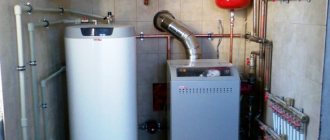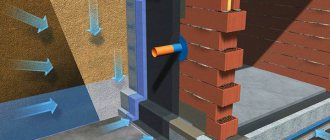Already with the onset of autumn in most regions of Russia, the air temperature drops to around zero, and car owners at this time are thinking about the need to change the wheels to winter tires, change the fluid to anti-freeze, check the battery, and also where to store their car. "iron horse" Leaving a car outside overnight means constantly warming it up in the morning, removing ice and snow from it, which is not very convenient, and also reduces the life of the car.
An alternative solution is to leave the car in the garage overnight, but what to do if it is unheated? How to heat it so that it is efficient and not very expensive? In this article, we will introduce you to all the possible solutions to this problem.
Why is it necessary to heat a garage?
Many Russian car owners own unheated garages. Everyone’s decision to buy or build such a garage was caused by different factors: perhaps for the sake of economy, perhaps the construction was intended to be temporary, etc. Of course, parking a car in such a garage is more advantageous than just on the street: the car will not suffer from the vagaries of bad weather , you won’t have to clear snow from your car in the morning, and in such a garage it’s just a couple of degrees warmer than outside.
However, an unheated garage is certainly less comfortable for both the car and its owner. The most common problems are that you have to get into a cold cabin, warm up the engine daily, regularly check tire pressure and fluid levels, which can change due to temperature changes.
By the way, the problem of temperature differences is also common when storing a car in a heated garage. So, when a car leaves a warm place in the cold, the windows and headlights often fog up, the paint on the body does not tolerate sudden changes, which in rare cases can even lead to peeling of the paintwork.
In this regard, the question arises: what temperature can be considered optimal for storing a car in winter?
What is the optimal temperature for a garage?
There is no universal answer to this question. Taking into account the above points, many experts agree that the car “loves cold rather than warm”, but without sharp fluctuations and in moderation. That is, the temperature in the garage should not be room temperature, it is optimal for it to be a little warmer than outside, only 7-10 degrees.
Of course, you shouldn’t take this recommendation head-on. If it is severely cold outside, 20-30 degrees or lower, it is better to maintain the temperature in the garage around zero. Otherwise, there is a high risk of simply not starting in the morning.
Plus, you need to take into account that when a car is left in the cold for a long time, the performance properties of its oils and technical fluids deteriorate. This leads to problems during startup and, as a result, premature wear of parts. In addition, cold air is usually more damp, which causes faster corrosion of parts and body elements.
The second factor to consider is how long you typically spend in the garage. If you enter it just to get in and start the car, that's one thing. If you often spend time in the garage, using it as a workshop or for other reasons, then it is obvious that the temperature in it should be as comfortable as possible for you, not the car. In this case, it is optimal to maintain the temperature in the garage at +12-15 C. Below we will look at how this can be done.
Do-it-yourself furnace
In addition to making a potbelly stove and organizing water heating, another common option for autonomous heating of a garage with your own hands is to use a waste oil stove. With its help, the air temperature in the room can be raised in a matter of minutes, using cheap fuel. To make a waste furnace, an old gas cylinder, well washed to remove gas residues, is most often used.
The operating procedure is as follows:
- The cylinder is equipped with two holes of 20 and 40 cm, at a distance of 5 cm from each other. There will be a firebox and an ash pan: this design allows the use of any type of solid fuel.
- To separate the heat exchanger from the chamber, a circle cut out of a steel sheet with a 10-15 cm hole for the burner is used. The burner in this case is a pipe with a series of holes.
- Before installation in the cylinder, the burner is welded to the circle. To make an evaporation container, you can use a brake disc or any other heat-resistant piece of metal.
Like a potbelly stove, exhaust furnaces can be supplemented with a water circuit and several radiators.
Basic ways and methods of garage insulation
Most often, garages are built from metal, brick and concrete - materials that have high heat loss. Obviously, in this case, heating such a room will require a lot of energy. That's why before choosing a heater for your garage, you need to consider its insulation. This will save your money and ensure the best result.
Here are some tips on how to do it correctly:
- Walls . The best solution is to insulate them from the outside. Of course, this is only possible if the garage is located in a protected area or surrounded by a fence. Otherwise, such protection will not last long. If this is not possible, then the walls are insulated from the inside;
- Ceiling . If the ceiling height in the garage is above 3 meters, then in order for the room to warm up faster and more economically, it is recommended to “lower the ceiling”. Considering the height of the car, of course. When pasting insulation, it is necessary to leave some space - an air gap. This can be done using wooden slats;
- Garage Doors . We insulate them in the same way as the walls and ceiling. Don't forget about vapor barrier. During periods of severe frost, it is recommended to cover the opening with thick fabric (tarpaulin) or cellophane. This will save heat when opening/closing the gate.
Now about the materials. The most popular and simplest option is foam insulation. It is quite light and thin (100 mm), but at the same time it is a very effective heat insulator. It is enough to stick it with mounting foam on the walls. To prevent moisture from getting into the seams, they are taped with tape.
Ordinary mineral wool is also suitable for insulating a garage. It is inexpensive, non-flammable, but is afraid of excess moisture. If moisture often accumulates in your garage, it is better to give preference to polystyrene foam.
High humidity is a problem in many garages. This is usually due to insufficiently thought-out construction technology. However, it should be borne in mind that warming up such a room will be much worse. The problem of garage vapor barrier can be solved by covering the inner layer of insulation with several layers of polyethylene. This prevents the formation of condensation on the cold outer wall, and as a result, the growth of mold and metal corrosion.
How to reduce heat loss and not go broke?
No heating system will be profitable and efficient if care is not taken to reduce heat loss. Heaters will waste a huge amount of energy resources. This is expensive and impractical, so you will have to insulate the gates, walls, floor and roof.
You can use expanded clay, polystyrene concrete, foil insulation, but the cheapest and most versatile option is polystyrene foam. It is suitable for insulating all structural elements.
It can also be used for thermal insulation of the floor, provided that a floating screed is made: polystyrene foam does not tolerate mechanical stress well, so it is filled with cement.
Foam is ideal for lining garage doors. The insulation is attached to a special sheathing, and the top is covered with external cladding - MDF boards, chipboard or plywood.
The ceiling, walls and garage doors are covered with polystyrene foam. There are two options - external or external wall decoration. Both are equally effective and allow for excellent thermal insulation of the building. The choice should be based on the convenience of the garage owner himself.
Choosing a heating system for the garage in winter
What is the best way to heat a garage? This is a common question asked by car owners. Basically, they use heating boilers for the garage, but there are other methods. To make your choice, you need to take into account the features of your garage space.
So, for example, if the garage is an extension or is located close to a residential building, and the system itself allows you to connect an additional load, then it would be correct to make a branch from the general water heating system to the garage. The total load must be calculated at the planning and installation stage of the heating system.
Of course, a single heating system for the house and garage is the optimal solution, but it is usually difficult to implement. Especially if the house has already been built. In this case, which happens most often, car owners choose an autonomous heating system for the garage.
In this case, it is necessary to take into account:
- The total cost of the heating system - installation plus further operation of the system;
- Selecting the optimal type of fuel . For example, if the garage is located near a forested area, then it would be optimal to use wood. And in areas where there are frequent power outages or the cost of kW is high, you should not install an electric heater;
- Complexity of installation and operating features . The more complex the system, the more expensive it is, and the more likely it is to fail. If the system requires constant monitoring by the owner, then it is better to abandon it;
- Fire safety . More on this at the end of the article.
Currently, the choice of heating systems is very large. Although some 20 years ago, practically the only available way to heat a garage in our country was a “potbelly stove”. Now it is also used, but there are more convenient, economical and practical methods. Let's tell you more about each.
Heating a garage with electrical appliances
This is perhaps one of the simplest methods, but at the same time, one of the most expensive for the car owner.
Advantages:
- Electric heating of a garage is easy to organize - buy the device you like (there are dozens of them on the market), select the required power, plug it into the socket;
- Simplicity and certain safety of operation. If all rules are followed, electric radiators are safe and do not emit combustion products. Easy to adjust the heating level, quick results.
Flaws:
- The main one is the high cost. Due to the high cost per kilowatt, the long operation of such heaters costs the owner a tidy sum;
- Not suitable for areas where there are frequent power outages;
- Electric radiators cool down quickly when switched off.
Conclusion: electrical appliances can be used for short-term operation - turned on for a specific job, then turned off. But they are convenient, because they do not require installation effort, they simply plug into an outlet, are easily adjusted and warm up the room quite quickly.
Warming up the garage with infrared heaters and convectors
In fact, these are also electrical appliances, but they can be classified as energy-saving. When properly connected, they can operate all cold weather with minimal energy consumption.
The principle of operation of an IR heater is similar to the thermal effect of the sun - it creates infrared heat rays that are absorbed by furnishings and walls, after which they release this heat back into the surrounding space.
The operation of an electric convector is based on the natural circulation of air, which enters from the bottom of the device, passes through the heating element and exits through special openings in the housing.
The advantages of such devices:
- low power consumption;
- safety (can be left on for a long time).
Minuses:
- poorly effective in severe frosts;
- It takes a long time to heat the room.
How to warm up a garage using gas heaters?
Heating a room with gas is more economical than previous methods. If the room is large and needs to be heated constantly, then a main gas pipeline is installed. Of course, this requires certain costs (paperwork, the installation of an expensive system, its regular maintenance), however, in the end, such a system will pay for itself.
A simpler and cheaper option for heating a garage is to use a liquefied gas cylinder. If installed correctly, such a system will serve you for a long time. You just need to change or fill the cylinder from time to time. It is connected to: a heat gun with a burner for burning gas, a ceramic heater and other necessary devices.
Advantages of gas systems: efficiency and high efficiency of the system.
Disadvantages: it is necessary to provide an exhaust hood in the garage, since during the operation of gas systems combustion products are released.
Will it be cheaper to heat a garage with wood, coal and other types of fuel?
Most car owners always want to find a simple and least expensive way to heat their garage. Potbelly stoves, boilers, and stoves are often used for this. However, this is not the best problem. Yes, such fuel is quite cheap and has high heat transfer. However, this is where the advantages of this solution end.
Minuses:
- firewood must be purchased constantly, plus find a place for proper storage;
- The efficiency of heating with wood and coal is quite low - most of the heat simply “flies down the drain”;
- you need to properly organize a place for a solid fuel boiler, which requires constant care and maintenance;
- Heating a garage with wood and coal is a rather labor-intensive process; you need to periodically monitor the amount of fuel in the stove and add new fuel.
Conclusion: If you plan to spend a lot of time in the garage in winter, then this is not your option. And truly safe and efficient solid fuel systems will cost no less than gas and electric heaters.
Other economical garage heating systems
In addition to those discussed above, the following heating systems are also available:
- Water heating . This is an option when the garage system is part of the overall heating system of the house. In this case, general heating occurs in the boiler room (boiler), and then the water passes through the pipes to the garage radiators, due to which the room is heated. Pros: reliability, high efficiency. After heating stops, the pipes remain hot for some time. The main disadvantage: the complexity and high cost of the system;
- Heating the garage with liquid fuel . Typically, used oils and diesel fuel are used as fuel. This solution is optimal for a car repair shop, where there is always a supply of used fluids. The system consists of two boilers - with liquids and gas. Combustion produces a large amount of energy. The advantage is that fuel is practically free. The disadvantages are the high cost of the stoves, the need for regular cleaning of the equipment, as well as the difficulty of igniting the stove;
- Air heating system for garage . Used quite rarely. The bottom line is that hot air enters the air duct system with deflectors from the heat gun, which is distributed and heats the room. This system allows you to quickly dry the air in the garage, thereby preventing metal corrosion. However, installing such a system is quite complicated, and therefore unpopular among owners.
Preparing the premises
Before installing the heating system, the garage is first prepared. To do this you will need:
- Install thermal insulation. The cheapest option is insulation with facade foam. But it is better to use mineral wool boards (non-flammable material, does not contribute to the spread of open fire). It should be installed from the outside, covering the insulation with decorative finishing (siding, lining, wood paneling). The roof should not be overlooked; it can also be insulated using basalt slabs or a layer of sawdust (closed in a wood or metal box to minimize the likelihood of fire).
Installation of thermal insulation will reduce heat loss by up to 60%. Fuel (or electricity) consumption will decrease similarly - Install the ventilation system. Even heating with electricity without normal air exchange will lead to the accumulation of fumes and carbon dioxide. Inhaling them for 2 - 3 minutes will inevitably lead to loss of consciousness.
- Prepare a place for installing a heating device. This should be an area of at least 1 by 1 meter, where there will be no flammable materials nearby.
- Install high-quality gates and doors. The main thing is to minimize possible heat loss. The garage is not heated regularly; heating is most often required “urgently” (as soon as possible).
- Install a fire safety system. Even smoke detectors are enough. But they will have to be temporarily turned off when the car warms up. The ideal option is an autonomous fire extinguishing system.
And after following the above recommendations, it makes sense to start arranging heating.
The simplest scheme for arranging natural ventilation. Corrugated aluminum pipes can be used as air ducts to save money.
Compliance with safety precautions when heating a garage
Since many flammable items, oils, solvents, and other flammable liquids are often stored in garages, the first requirement for a future heating system is that it must fully meet all safety requirements.
Basic safety requirements:
- For the storage of fuels and lubricants, a certain place must be allocated, located at a distance from heating devices and located at a certain elevation from the floor;
- The floor and walls near the heating equipment must be upholstered or, in extreme cases, covered with metal sheets;
- There should be a fire extinguisher and a box with asbestos fabric next to the devices;
- The heating system should not be left unattended for a long time;
- Electrical wiring must not contain twists or breaks and must be grounded;
- Regardless of the heating system used, it is recommended to provide exhaust or ventilation in the garage;
- A garage is not a place to store old things and furniture. Remember that they are the main cause of many fires;
- Try to avoid smoking in the garage. As a last resort, do this far from heating appliances and fuel storage areas;
- Do not install electrical appliances in damp areas;
- Install simple smoke and fire detectors on the ceiling. Thanks to them, you will have time to react in time and save your and your neighbors’ property.
In conclusion, we note that the chosen heating method will determine not only the overall temperature conditions, but also a comfortable stay in the garage, as well as the performance and durability of your car. So, before it gets too cold or frost sets in, it’s time to choose the right insulation and heating solution for your garage.
Did you find this article helpful? Please share it on social networks: Don't forget to bookmark the Nedvio website. We talk about construction, renovation, and country real estate in an interesting, useful and understandable way.
Solid fuel
The most inexpensive and easiest way to heat a garage is to install a small-sized stove such as a potbelly stove. In this case, wood or coal is usually used as fuel. The stove should be located as far as possible from flammable materials and fuel. It is best to choose a corner that is not cluttered with foreign objects for these purposes. By the way, you don’t have to pay money for a potbelly stove, since such products can easily be made independently. For these purposes, a metal sheet or an old steel barrel is usually used. The only condition is that the metal thickness should not be less than 5 mm. Sheet metal is more suitable for cubic designs, while barrel is more suitable for rounded ones.
In addition, you will need a corner, pipes and plumbing tools. It is best to make a niche for the chimney on top of the stove: its diameter should not be less than 12 cm. The pipe should be no thinner than 3 mm, in order to avoid rapid burnout. The lower part under the firebox serves as a chamber for collecting ash: it is advisable to equip it with a metal grate.
The size of the holes between the slots depends on the type of fuel used:
- For coal and small wood chips, a size of 1 cm is suitable.
- If we are talking about large logs, then the size of the holes is made at least 4 cm.
To simplify the removal of ash, a special retractable box is made of durable steel under the grate. To increase the efficiency of a homemade potbelly stove, its walls are equipped with welded metal plates with a thickness of 5 mm. In this way, expansion of the heating area of the device is achieved. When operating a potbelly stove, you need to be prepared for the smell of smoke. You also need to provide space for firewood and coal.











